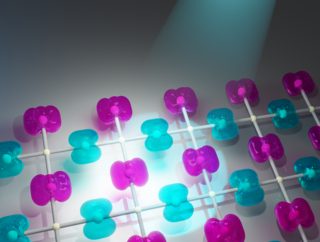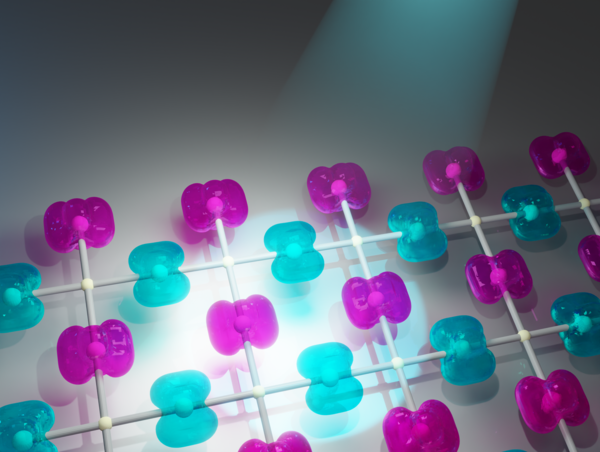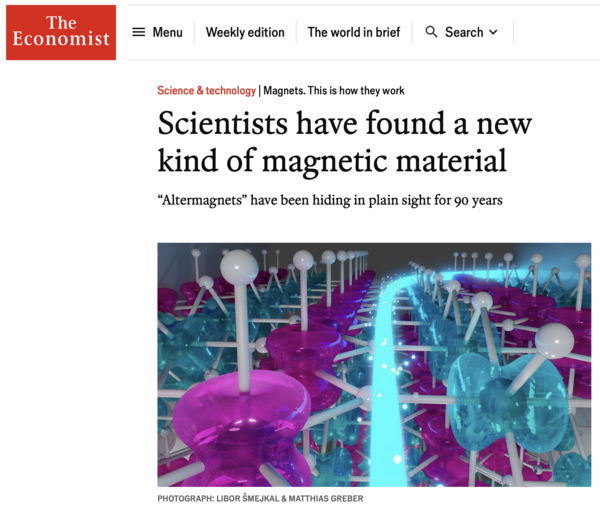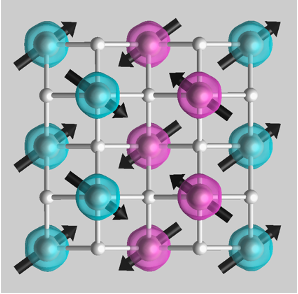
Functional Quantum Matter
Welcome to our group "Functional quantum matter"
Our research covers a range of topics in quantum solid-state physics, focusing on unconventional magnets, such as altermagnets, topological materials, and quantum phases that arise from strong correlations and quantum coherence. We investigate these systems by developing analytical and computational tools based on symmetry and ab initio electronic structure theory. Our vision is to achieve fundamental theoretical but experimentally testable scientific advances with potential functionalities in future energy-efficient, sustainable, and ultra-scalable nanoelectronics and spintronics.
See below for news and more information about our recent research.

Altermagnetism recognised among "Top 10 Breakthroughs of 2024"
The discovery of altermagnetism has been included by Science Magazine in the list of the "top science breakthroughs of 2024". This discovery is the only entry from the field of physics on the prestigious list, which is led by advances in HIV medicine and also includes the landing of a space rocket.
Proposal of altermagnetoelectric effect
Recently we have predicted an unconventional class of altermagnets which exhibit ferroelectricity. Furhtermore we have shown that there exist a subclass of altermagnetic multiferroics where electric fields can switch the altermagnetic spin polarisation.
L. Šmejkal, “Altermagnetic multiferroics and altermagnetoelectric effect,” arXiv:2411.19928.
K. Wright, “Altermagnets That Turn On and Off”, March 13, 2025, Physics 18, 58
Altermagnetism reaches outside of science

Altermagnetism was recently featured in the media including The Economist.
Nanoscale mapping of altermagnetism
An international team of researchers, including Libor Šmejkal, has revealed nanoscale mapping of altermagnetism. The experimental work was led by researchers from Nottingham, who successfully mapped altermagnetic domains in Manganese Telluride. They also demonstrated control of these domains through nanopatterning and the application of magnetic fields. Observing x-ray magnetic circular dichroism in altermagnets also serves as confirmation of the unconventional time-reversal symmetry-breaking electronic structure proposed several years ago. The experiment was designed based on earlier predictions by Libor Šmejkal.
O. J. Amin, A. Dal Din et al., Nature 636, 348 (2024)
L. Šmejkal et al., Science Adv. 6, 23 (2020)
Unconventional p-wave magnets

Recent discovery of altermagnets, magnets with spin polarised order parameters in the form of even-parity d,g,i- wave symmetry, raises a question whther also odd-parity wave magnets can exist and can be identified by spin group theory. In this preprint we answer the questioin in affirmative and demonstrate p-wave magnetism by spin group analysis and first principle calculations and propose it can exhibit large spontaneous transport anisotropy readily detectable in experiments.
Unconventional p-wave magnets
Anna Birk Hellenes, et al.
arXiv:2308.03851
Falling Walls Science Breaktroughs 2024 Finalists announced

The selected finalists for this year's Falling Walls Scientific Breakthrough of the Year 2024 have been announced. Congratulations! In last year's Falling Walls, we had been honored to explain our research. Thanks to fantastic artists, we illustrated altermagnetic spin currents on a dancing couple dressed in black and white, showing the up and down spin of electrons. We look forward to this November's conference!
https://falling-walls.com/de/node/937
https://www.youtube.com/watch?v=FKD_ZCQzFog
Prediction of electric spin generation in d-wave altermagnets
Together with University of Regensburg, we have predicted current induced spin polarisation in altermagnets. In our work, we show that large bulk nonequilibrium spin polarisation can be generated due to an unconventional nonlinear spin susceptibility allowed in centrosymmetric altermagnets which goes beyond the conventional mechanisms based on linear effect due to relativistic spin-orbit coupling in noncentrosymmetric systems.
L. Golub & L.Šmejkal, arXiv:2503.12203